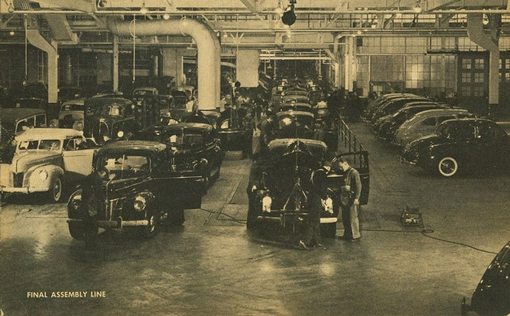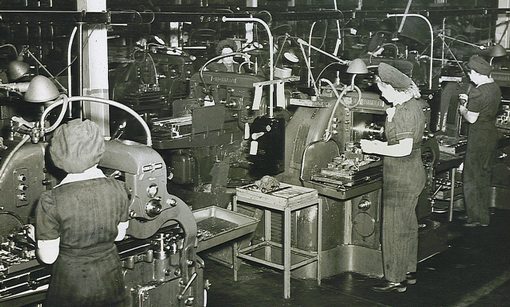Surviving on a Creative Assembly Line
Do you ever feel like you do the same thing all day every day? Do you wonder how you can possibly be expected to come up with original and creative ideas almost ceaselessly?
Join the club. Today we’re going to talk about how and why designers struggle with creativity, some tips for avoiding burn out and whether or not you should tough it out or get out while you still can.
Living the Dream
Being a creative professional is my dream job. Design, writing, photography, these are the kinds of things people imagine making money from while they clock in and out of jobs that they hate. I was lucky enough to fall into this industry very early in life and have been at it for nearly a decade. I’m extremely grateful for the opportunities that I’ve had to make a living doing something that I love and to be honest, I can’t imagine doing anything else.
However, once you’ve been doing this for a while, the natural reaction is a tendency towards burnout. Creativity is an interesting beast. It comes and goes of its own volition and is very difficult to reign in and take control of in a productive manner. It’s a delicate flame and if you push it too hard, it’ll snuff out completely.
Many professions can take creativity as it comes. They appreciate it when it’s there and rely on solid business practices and experience when it’s not. We don’t really have that luxury. Let’s face it, we’re bastardizing artistic creativity with mass production. At times I feel like a glorified assembly line worker, constantly forced to dish out supposedly “original” content so that I can pay my bills.
Even here at Design Shack! I turn out three to four articles per week. You know the hardest part? Simply coming up with topics to write about. I long ago lost count of how many design articles I’ve written and am hard-pressed to find new things to teach and discuss every week.
So the question becomes one of survival. How can you make it in an industry that expects you to be a never-ending fount of creative thought? Everyone has their limit and I’ve seen the best of them crash and burn hard at one time or another. Some push through and some leave and never look back. What’s the difference between the two? Which person should you be?
Let’s take a look at some tricks of the trade that can keep you fresh.
Vary the Tasks
Henry Ford’s assembly line revolutionized the world of production and is perhaps one of the most important developments in history that led to the astoundingly productive planet that we live on today.

It wasn’t without its problems though, namely, people (hence these being replaced wherever possible). People tend to freak out on assembly lines. You perform the same mind-numbing task day in and day out for a few years and something just breaks in your head. What seems like a great job to an employer can be psychological torture to an employee.
One helpful solution to this problem is to vary the tasks that a given person performs. By training workers on several aspects of the assembly line, you enable people to move around and get away from performing the same thing over and over.
Another solution to the same problem was found in allowing a worker to actually create the majority of an object. For instance, if you’re building pocket watches, you can either have each person on the assembly line insert a single gear over and over or allow each person to perform several tasks that result in a fairly finished watch. It turns out, worker satisfaction tends to be higher if they see the result of their labor and can take credit for several aspects of it. Like the previous solution, this also varies the tasks that they perform.

I learned this knowledge in a business school management class but apply it to my life as a freelance creative. As I mentioned above, I don’t just design, I’m also a writer and a photographer. I’ve learned to make decent money in all three of these tasks and can shift my focus when one starts to wear on me too heavily.
This is obviously a variation of the first solution. You can also pursue the second solution by expanding how much you can do on a project. If you’re just a front-end designer, try learning to code. By expanding the number of things you do on a given project, you can raise your prices and make your job less monotonous.
Challenge Yourself
This is extremely important and can really help you avoid hitting a creative wall. When you’re constantly challenging yourself to do new things, it keeps you interested and grows your skill set. Sure, projects go by much quicker if you build habits and churn out projects as quickly as possible, but you’re crippling yourself in the long run by setting a trend aimed right at professional stagnation.
If you’re constantly learning and trying new things, you’ll stay interested. Set your sights high and aim to deliver projects that are just beyond your scope of skills. Can you create a website but not a WordPress theme? Take a job creating one and you’ll force yourself to learn. Want to improve your skills as an artist? Create and sell a custom icon set.
As you pick up new skills you’ll find that you’re actually avoiding boredom. You’ll amass a ton of creative tools that you can selectively apply to different projects, the more you have the longer you can go without feeling like you do the same tricks on every project.
Inspiration
This concept ties very closely in with the idea of finding creative inspiration. Bash design galleries all you want but the day you run out of ideas they just might save your career. A consistent diet of design inspiration doesn’t provide designs to rip off but a constant stream of fresh ideas to combine, build on and evolve.
For me, design inspiration gives me something to aspire to. When I see the work of better designers than me it challenges me to work harder and try to increase my level of talent to be on par with the people that I respect. I’ll often see a Photoshop texture or CSS trick and attempt to replicate it just to learn about the process.
Is Design Your Passion?

The design community is practically a cult. We have our own little language that no one else remotely understands, exclusive networks, propaganda, hype-building conferences and most importantly, a shared way of viewing the world that is unique to the people inside the bubble.
Can you survive outside the cult? Absolutely. But there’s a reason it exists. We designers tend to really love what we do and are eager to interact with others who feel the same. We get excited about fonts for crying out loud, you’re not going to find that quality in anyone normal.
The point that I’m driving home here is that many of us have gone far beyond design as a profession into design as a passion. Design isn’t just how we collect a paycheck, it defines who we are as people. I dedicate countless hours of my free time to reading and learning about design. Yes, it helps me do my job better but that’s a positive side effect to the fact that it’s simply something I enjoy doing. Find me someone who pursues their profession as a hobby when they aren’t on the clock and I’ll show you someone who is absolutely passionate about what they do.
Find an Escape
That being said, make sure you get out of the house regularly! Design is a great hobby, but you need to find a place where you can go and forget about work for a few hours. This is nearly impossible for me as I tend to think and stress about work 24/7. I think about work when I drive, during meals and while watching movies. Even as a regularly performing musician I often find my brain wandering to work as I play on stage!
Last year I decided to take up karate because I’m a lazy desk jockey and needed a fun way to get in shape. Classes are gruelingly difficult and require more physical exertion than I imagined, so much so that I often can’t focus on anything but getting through it. Those 2-3 hours per week are perhaps the longest waking stretch I have that are completely free of work-related stress. Consequently, I walk away feeling amazing and refreshed.
Trust me, you need to find your own karate lesson, something that you enjoy that takes your mind far away from design and forced creativity. It will change your whole world.
Love It or Leave It
To survive on the creative assembly line you have to love what you do. No matter what, you’ll hit that burn out stage at some point or another. You’ll get fed up with the entire industry, you’ll feel completely drained of intellectual capacity and you’ll long to do something else with your life. From here, one of two things will happen. If you love what you do, you’ll get out of that lull. Even if you leave, you’ll come back because ultimately, you couldn’t be happier do anything else for a living.
The second possibility is that you’ll realize that you never really loved your job as a designer. You’ve always survived from weekend to weekend and hated everything in between and were never crazy enough to waste your free time honing your skill. If this is you, take my advice, you won’t make it. One day the machine in your head will stop producing. The quality of your work will slip and you’ll resent a life spent beating your brain into submission.
Being a creative machine is not for everyone. Stress levels are high and you can never be completely sure that you’re next project will be a success. Some of us get a strange high from that, others never develop the stomach for it. Either way, I won’t blame you for daydreaming about a job that doesn’t require any creativity whatsoever. I sure do.
Photo Credits: Alden Jewell, Vince Chan and Gary Blakeley.